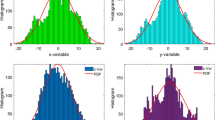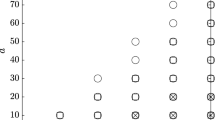Abstract
In this paper, a new method for reducing the order of nonlinear large-scale fractional-order systems is presented. The considered system has a nonlinear large-scale dynamic. The proposed method is developed by introducing a new fractional-based approach for neural network learning. According to the fractional-order modeling of the system, the structure of the neural network is selected as a recurrent neural network and new design and analysis are done on this network. In order to show the proposed method for model reduction has an acceptable error, a novel fractional-order stability analysis is used to derive the neural network weighting function. Moreover, it can be concluded that the proposed reducing method can preserve the main properties of the original system like a system’s stability. Simulation examples are provided to show the effectiveness of the proposed method. Finally, the proposed method is compared with the existing methods and advantages of the proposed method are shown.











Similar content being viewed by others
References
Akgül A, Khan Y (2017) A novel simulation methodology of fractional order nuclear science model. Math Methods Appl Sci 40(17):6208–19
Ardeshiri RR, Khooban MH, Noshadi A, Vafamand N, Rakhshan M (2019) Robotic manipulator control based on an optimal fractional-order fuzzy PID approach: SiL real-time simulation. Soft Comput 1:1–2
Behinfaraz R, Badamchizadeh MA (2018) Synchronization of different fractional order chaotic systems with time-varying parameter and orders. ISA Trans 1(80):399–410
Behinfaraz R, Ghaemi S, Khanmohammadi S (2015) Adaptive synchronization of new fractional-order chaotic systems with fractional adaption laws based on risk analysis. Math Methods Appl Sci 42:1772
Bettayeb M, Al-Saggaf UM, Djennoune S (2018) Single channel secure communication scheme based on synchronization of fractional-order chaotic Chua’s systems. Trans Inst Measur Control 40(13):3651–64
Boubellouta A, Boulkroune A (2019) Intelligent fractional-order control-based projective synchronization for chaotic optical systems. Soft Comput 23(14):5367–84
Carlberg Kevin et al (2013) The GNAT method for nonlinear model reduction: effective implementation and application to computational fluid dynamics and turbulent flows. J Comput Phys 242:623–647
Carlberg Kevin, Barone Matthew, Antil Harbir (2017) Galerkin v. least-squares Petrov–Galerkin projection in nonlinear model reduction. J Comput Phys 330:693–734
Coolidge JL (1949) The story of the binomial theorem. Am Math Mon 56:147–157
Diethelm Kai, Ford Neville J, Freed Alan D (2004) Detailed error analysis for a fractional Adams method. Numer Algorithms 36(1):31–52
Efe MÖ (2009) ADALINE, based robust control in robotics, a Riemann–Liouville fractional differintegration based learning scheme. Soft Comput 13(1):23–9
Gao Yang, Joo Er Meng (2005) NARMAX time series model prediction: feedforward and fuzzy neural network approaches. Fuzzy Sets and Systems 150(2):331–350
Guo J, Sun Z, Tang H, Jia X, Wang S, Yan X, Ye G, Wu G (2016) Hybrid optimization algorithm of particle swarm optimization and cuckoo search for preventive maintenance period optimization. Discrete Dyn Nat Soc
Hagan MT, Jesus OD, Schultz R (2001) Training recurrent networks for filtering and control. In: Medsker LR, Jain LC (eds) Recurrent neural networks design and applications. CRC Press, Boca Raton
Hong WC, Li MW, Geng J, Zhang Y (2019) Novel chaotic bat algorithm for forecasting complex motion of floating platforms. Appl Math Model 1(72):425–43
Ivanov DV (2015) Identification discrete fractional order Hammerstein systems. In: 2015 International Siberian conference on control and communications (SIBCON) May 21. IEEE, pp 1–4
Kazemi A, Behinfaraz R, Ghiasi AR (2017) Accurate model reduction of large scale systems using adaptive multi-objective particle swarm optimization algorithm. In: 2017 international conference on mechanical, system and control engineering (ICMSC). IEEE
Kumar R, Srivastava S, Gupta JR (2017) Lyapunov stability-based control and identification of nonlinear dynamical systems using adaptive dynamic programming. Soft Comput 21(15):4465–80
Kumar R, Srivastava S, Gupta JR, Mohindru A (2019) Comparative study of neural networks for dynamic nonlinear systems identification. Soft Comput 23(1):101–14
Kundra H, Sadawarti H (2015) Hybrid algorithm of cuckoo search and particle swarm optimization for natural terrain feature extraction. Res J Inf Technol 7(1):58–69
Lall Sanjay, Marsden Jerrold E, Glavaški Sonja (2002) A subspace approach to balanced truncation for model reduction of nonlinear control systems. Int J Robust Nonlinear Control 12(6):519–535
Maurya MK, Kumar A (2017) Dimension reduction and controller design for large scale systems using balanced truncation. In: 2017 1st International conference on electronics, materials engineering and nano-technology (IEMENTech). IEEE
Nadeem M, Banka H, Venugopal R (2018) A neural network-based approach for steady-state modelling and simulation of continuous balling process. Soft Comput 22(3):873–87
Pakazad Sina Khoshfetrat et al (2017) Distributed semidefinite programming with application to large-scale system analysis. IEEE Trans Autom Control 63:1045
Pant T, Han C, Wang H (2019) Examination of errors of table integration in flamelet/progress variable modeling of a turbulent non-premixed jet flame. Appl Math Model 1(72):369–84
Pineda Fernando J (1987) Generalization of back-propagation to recurrent neural networks. Phys Rev Lett 59.19:2229
Ray SS, Sahoo S, Das S (2016) Formulation and solutions of fractional continuously variable order mass-spring-damper systems controlled by viscoelastic and viscous-viscoelastic dampers. Adv Mech Eng 8(5):1687814016646505
Rydel M, Stanisławski R, Latawiec KJ, Gałek M (2018) Model order reduction of commensurate linear discrete-time fractional-order systems. IFAC Pap OnLine 51(1):536–41
Siegelmann HT, Horne BG, Lee Giles C (1997) Computational capabilities of recurrent NARX neural networks. IEEE Trans Syst Man Cybern Part B 27:208
Truhar N, Veselić K (2007) Bounds on the trace of a solution to the Lyapunov equation with a general stable matrix. Syst Control Lett 56(7–8):493–503
Uçak K (2019) A Runge-Kutta neural network-based control method for nonlinear MIMO systems. Soft Comput 23(17):7769–803
Uddin MM (2018) Gramian-based model-order reduction of constrained structural dynamic systems. IET Control Theory Appl 12(17):2337–46
Vasu G, Sivakumar M, Ramalingaraju M (2019) A novel model reduction approach for linear time-invariant systems via enhanced PSO-DV algorithm and improved MPPA method. Proc Inst Mech Eng Part I J Syst Control Eng 23:0959651819849372
Zhang X, Long L, Lv Y (2018) Control and simulation of fractional order inverted pendulum systems. In: 2018 Chinese control and decision conference (CCDC) June 9, pp 6736–6741. IEEE
Zhang Z, Hong WC (2019) Electric load forecasting by complete ensemble empirical mode decomposition adaptive noise and support vector regression with quantum-based dragonfly algorithm. Nonlinear Dyn 98(2):1107–36
Author information
Authors and Affiliations
Corresponding author
Ethics declarations
Conflict of interest
The authors declare that they have no conflict of interest.
Ethical approval
This study does not contain any studies with human participants or animals performed by any of the authors.
Informed consent
Informed consent was obtained from all individual participants included in the study.
Additional information
Communicated by V. Loia.
Publisher's Note
Springer Nature remains neutral with regard to jurisdictional claims in published maps and institutional affiliations.
Rights and permissions
About this article
Cite this article
Jahanbakhti, H. A novel fractional-order neural network for model reduction of large-scale systems with fractional-order nonlinear structure. Soft Comput 24, 13489–13499 (2020). https://doi.org/10.1007/s00500-020-04763-5
Published:
Issue Date:
DOI: https://doi.org/10.1007/s00500-020-04763-5




